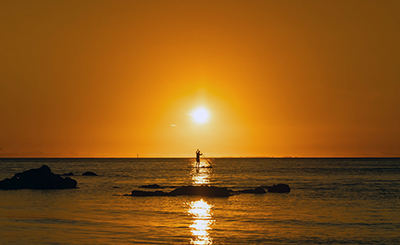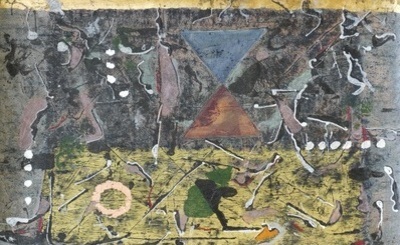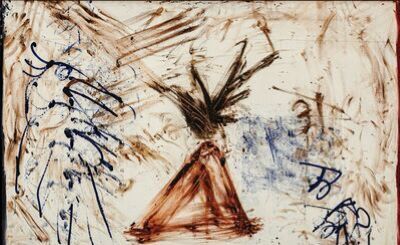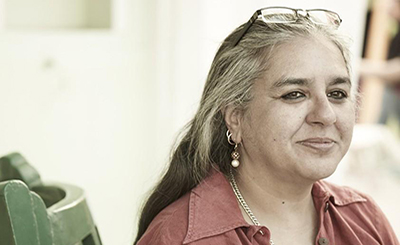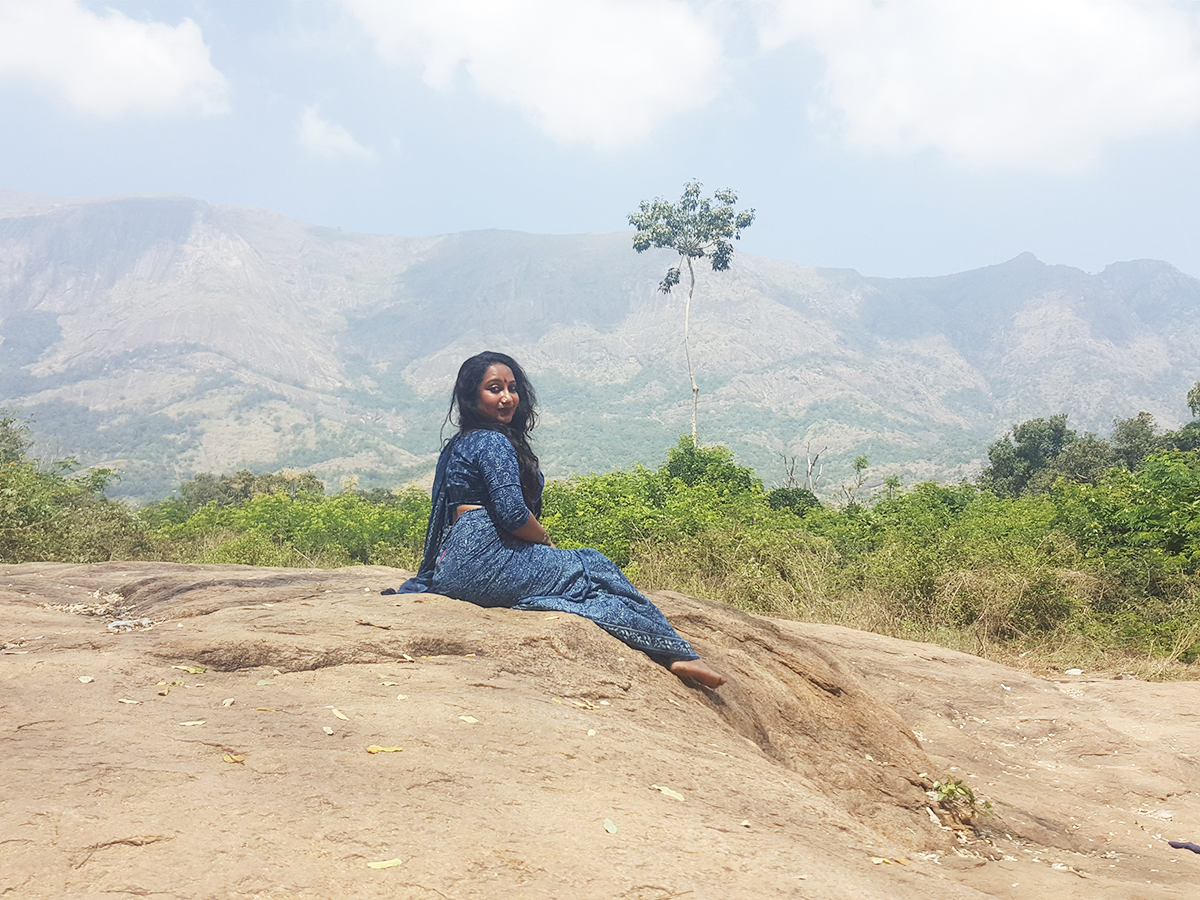
Sharanya Manivannan in Shenbaga Thoppu. Photo: Shiamala Komahan
Among the 12 canonised Tamil Vaishnavite poets known as Alvars, Andal is the only woman. In her own lifetime, she was known by the name Kodhai. It is Kodhai, the teenaged author of the Tiruppavai and the Nachiyar Tirumoli, who is the subject of my novel, The Queen of Jasmine Country.
Standing on a railway platform on a night in February, afraid to board even five minutes before the train departs due to a confusion over unconfirmed tickets, my travel companion and I, her toddler sitting on her shoulders, have no way of knowing if we will arrive in Madurai at the break of dawn. Over the previous few weeks, I’ve been writing a manuscript set in medieval Tamilagam, at a time when the city of Madurai was the capital of the Pandya empire. My main destination is just a little to the South, to a town now called Srivilliputtur, but known to my protagonist — a poet — as Puduvai.I want to go to the places where she had been, where she had lived and longed for something more than what her life had given her. I’d read and re-read Andal’s poetry for years. I’d murmured her lines to myself on bleak mornings when it had felt like my own vocabulary had seeped out of my veins. She’d come to me in dreams, and a story about her had been pouring out of me. But I have never been to Srivilliputtur.
Among the 12 canonised Tamil Vaishnavite poets known as the Alvars, Andal is the only woman. Historical detail about her is scant, subsumed into hagiography, but she is likely to have written her poems around 850CE. In that widely-known hagiography, she was a foundling who adored Vishnu, and as she grew, she would steal and wear the garland that her father made for the deity every morning. One day, she is caught, but the deity insists in a dream that he will only wear the garlands that have graced her first. As she becomes a woman, she vows to marry no one but Vishnu himself — and eventually, in that glittering and cherished hagiography, she does. “Andal” is an epithet, meaning “she who rules”. In her own lifetime, she was known by the name Kodhai. It is Kodhai, the teenaged author of the Tiruppavai and the Nachiyar Tirumoli, perfectly unaware of the grandeur that will eventually be bestowed on her, who is the subject of my novel, The Queen of Jasmine Country.
Miraculously, we find the ticket inspector just before the train departs, and he allows us to share a bunk. And we find ourselves driving out of Madurai early the next morning, in that dry but still not scorching season of the Tamil calendar when everything prevaricates on the cusp of blooming. In Srivilliputtur, we buy garlands of tulasi to take into the three-sectioned temple complex that is the town’s nucleus. It is divided into the Andal-Rangamannar temple, the garden known as the Nandavanamat the centre, and the Vatapatrasayi temple. In the stonework on the ground leading to the first are carved parrots, precious to Andal — and the vehicle of Kamadeva, the god of lust who she addressed in her poems, demanding that he unite her with Vishnu.
In her poems, she girlishly panegyrises Puduvai as a city of towers, and herself as the daughter of a king. I’ve been told that the place has changed dramatically in recent decades; visitors of the past paint a picture of a small town whose preeminent deity was spoken of as though she was a girl from one’s own extended family, someone whose ritual wedding brought joy, drama and risqué banter to the community. But a kumbhabishegam, a new gold vimana, and the commerce and endowments that came with increased pilgrim footfall have altered it. Today, it is like any pilgrim town in South India, coming alive at certain points of the calendar. Srivilliputtur’s other claim to fame is a milk sweet named paalkova, which is sold in shop after shop, in packaging often branded with Andal’s image.
Because my novel is about the life of Kodhai, not Andal, I am able to brush away my disappointment in the Andal-Rangamannar shrine. To me, it seems like any temple to Vishnu, flanked by consorts or attendants. I am not even certain whether I’ve made out where she is within it. We circle back; I take my friend’s word that she is there, more compelling in the dark statues in the far wall at the back than amongst the idols in the front of the sanctum. But I am not moved. But circling the sanctum, we see that behind it is a painting of Narasimhar, Vishnu in his most ferocious avatar, and there is something reassuring about seeing him. I have always had the sense that even though it was the dapper, delinquent Krishna her poems seem to call for, the one the poet was truly in love with was the lion-man.
We begin walking away, pausing to take a few pictures in the sunlight slanting on the ancient stone. And then, my friend and I split up for a few minutes; her son has asked for something.
And that’s when I find her — my Kodhai-Andal — not standing by someone else’s shoulder, not relegated to the shadows, but sovereign. In the corridor between the two Vishnu temples is her nandavanam, the garden in which legend has it that she was discovered. A pot of tulasi, said to be the very one she was found beneath, stands before her altar. She is without consort here, without excess of any kind. I offer the garland of tulasi I have held on to for her, even though it is flowers that are usually given to her. It was the tulasi garland that her father made that she coveted as a child, after all.
Here, she is luminously cast in black granite. Both central and liminal at once, in this space between two temples. I sit alone for a long time in her garden. When my friend returns, she asks me simply: “Did you find what you were looking for?”
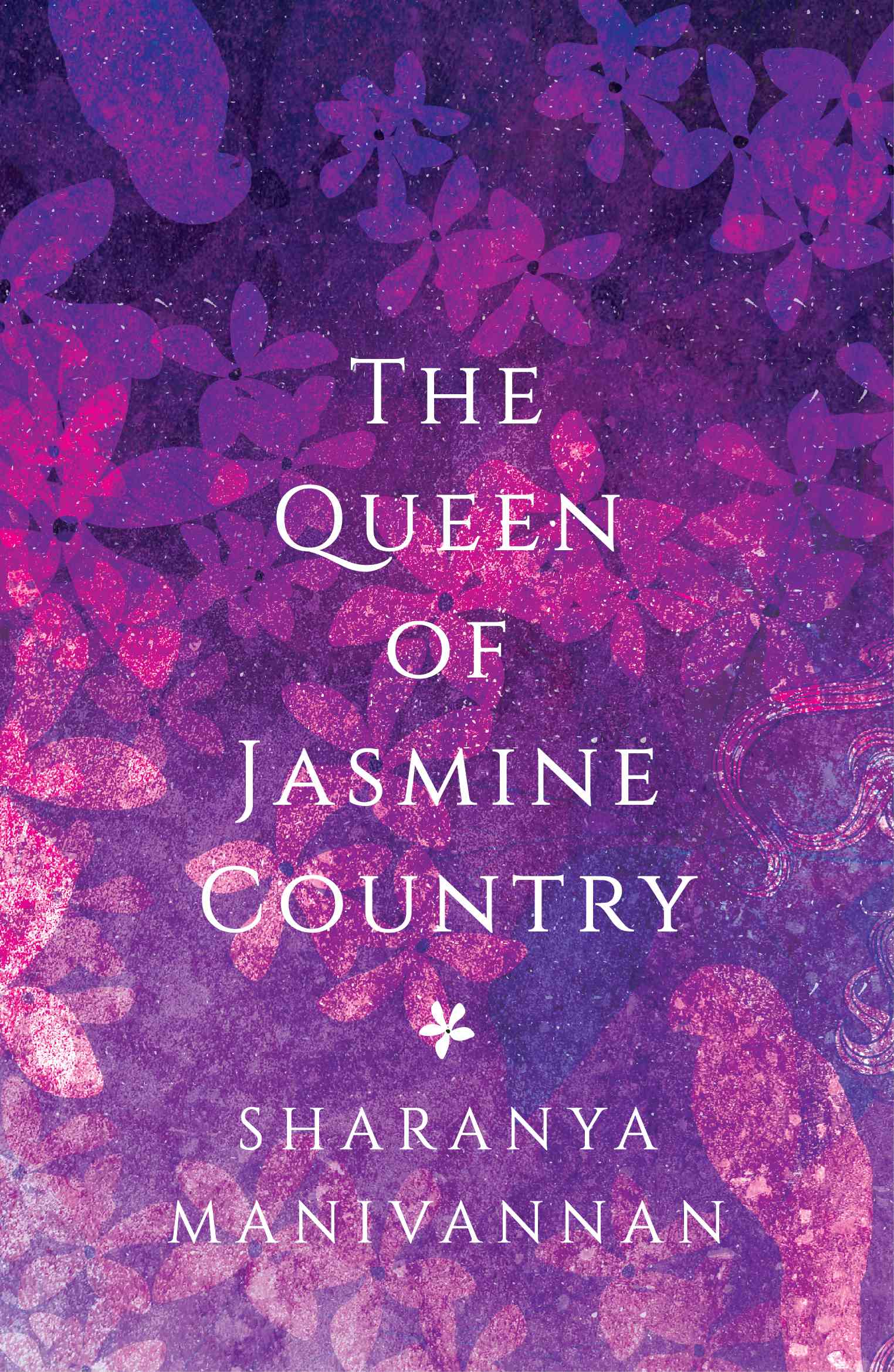
The final temple in the complex is a two-storey edifice. On the upper level is Vishnu as Vatapatrasayi, reclining beneath a banyan tree. And on the ground level, there he is again: the enigmatic Narasimhar. Devotees believe that this temple was where Kodhai and her father Vishnuchittan (who later would be known as Periyalvar, and was himself one of the Alvars) worshipped, and where her worn garland was offered each day. The other two portions of the temple were added later, somewhere in the centuries following her life — when Kodhai became Andal, and thus first a saint and then a goddess.
Towards an exit to the street, there is a sanctum to another glorious poet, Nammalvar, and here I pause in reverence. Although only Andal is given divine status among the Alvars, to a writer, Nammalvar is no less worthy of veneration. In the 12th century Divyasuricharitram by Garuda Vahana Pandita, Nammalvar instructs Kodhai’s friend, Anugraha, to sing to her of each manifestation of Vishnu. Her response to hearing of Ranganatha of Srirangam is duly noted, and the wedding is fixed. I am far from the only one, through history, whose imagination has been kindled by some version of her story. But more than any story, it is her own poetry that matters to me. It contradicts and complicates the hagiography, when the literature itself is overshadowed by the legend. Her joyous, supplicating Tiruppavai is chanted liturgically, whereas her despairing and sensual Nachiyar Tirumoli is often elided.
Our pilgrimage goes beyond this temple complex, and this town. Very little is known about quotidian life in 9th century Tamilagam, and my instinct is that only in nature will we find some semblance of what the fabric of Kodhai’s days were like. Shenbaga Thoppu, 8 km from Srivilliputtur, literally means “grove of magnolias”. Today, it remains a forested region, thanks to its status as a sanctuary for the endemic grizzled squirrel, and its shared border with the Periyar Tiger Reserve. The foliage and most definitely the wildlife of the 9th century would have been more dense, but standing with our feet wet mid-stream as monkeys screech in the trees above us, I am certain: it would not have been that different. Not to a passionate girl who finds solace in the play of light on the leaves. Not to a lonely young woman caressing petals and deer-down, contemplating the nature of the heart. And certainly not to another writer, even a thousand two hundred years apart. The Kodhai in my book — who lives her whole life without having seen the ocean — escapes into that lushness when the smallness of her town, or perhaps of mortal life itself, frustrates her.
The Western Ghats are within sight. Whatever else existed in her time by way of edifices or paths, Kodhai certainly knew the vision of those peaks. It is easy to imagine her: walking deeper into the forest, lifting her hems as she crossed small streams, stopping for elephant traffic, while the magnolia she tucked into her ear wilts through the course of the day. I lift my eyes to the mountains and drink in the certainty that what I see is very close to what she too must have seen.
Our driver is frightened by the possibility of drunk picnickers on this Saturday afternoon, although we are keen to go further, to see the places where waterfalls thrive in more torrential months. He drives us at his own behest to a temple to Pechi Amman in the foothills, trying to give us a tamer, tourist-y experience. Only there’s nothing touristy, and certainly nothing tame, about Pechi Amman, a ferocious Tamil goddess who looks over mothers and children. What drew us here, or anywhere? Will, of course — but there is something beyond ourselves too. It is what Kodhai reached for in her poetry. What so many human beings reach for, calling it faith or mystery or even while refusing to name it. So we worship at the goddess’ temple too, and we wonder at all our journeys so far; my friend and I met when we were 7 years old, and here we are now, travelling with her own child. He is too young to commit this day to memory.
There are other temples in this wilderness, including at least one more associated with Andal. Legend has it that Vishnu as Kallalagar (“the beautiful one in stone”) had come to Srivilliputtur to marry Andal, only to learn that she had already departed to Srirangam to marry Ranganatha. Instead, he settled in the ghats and became Kattalagar (“the beautiful one of the forest”). We return to the highway, and head instead to his original abode, where we know from her poems that Kodhai worshipped.
Under an hour north from Madurai, through more bucolic landscapes, is Kallalagar’s Alagar Koyil, the temple which appears in Andal’s poetry as Tirumaliruncholai. This is where she promises one hundred pots of butter and one hundred pots of ghee to him, if only he will fulfill her desires. In some of the most striking lines in Nachiyar Tirumoli, she entreats him to come to her and smear with his embrace the saffron paste she has applied on her breasts.
We find him — Alagar —as beautiful as his name implies. Long-limbed and finely-hewn. Centuries before Andal would have a sanctum here herself, Kodhai came and feasted on the sight of him. As the curtains part and the crowd cries out, “Govinda, Govinda”, so do we.
Alagar Koil is unlike most Tamil Vaishnavite temples, for it is richly charged with an energy that most succinctly can be described as non-Brahminical. Just before the temple’s main entrance is a shrine to Karuppanaswamy, with doors that remain closed but for one day of the year. Garlanded goats that appear to be being prepared for sacrifice wander beside the gaushala. Above Alagar Koil, after a beautiful uphill drive, is Pazhamudir Cholai, one of the six sacred armories of Murugan, the patron god of the Tamil people. A gateway to the right of the temple leads to a shrine to the goddess Rakhee Amman. All these elements combined are strange and stirring. In my book, this is the place where Kodhai begins secret rites to Kamadeva, god of carnal desire and pleasure. It is not difficult to imagine that he too had a shrine somewhere on this lushly potent hill.
Within the temple too, the sense of being in a place that has resisted monolithic cultural imposition persists. Before one of the shrines of Narasimhar,a woman standing right behind me begins to breathe heavily. I move aside quickly and see that she is shaking, overcome by divine possession. Neither the priest nor other supplicants react; we surmise that this is not an unusual occurrence for this temple.
At Andal’s sanctum, we offer tulasi again.
As we return to Madurai, we cross a tributary of the Vaigai, and I wonder — is this the Cilampu river that appears in Andal’s poems, which unlike this rivulet have not diminished over time?
There is a John Updike poem entitled “Madurai” in which the city’s presiding deity — the fish-eyed goddess Meenakshi — makes no appearance, but Vishnu does. I had thought it a work of a sort of ignorant exotica, but travelling to Alagar Koyil has reconfigured my own perceptions of Madurai from afar. Perhaps Updike too had been stricken (and smitten) by the beautiful one in stone. The month of Masi has just begun in the Tamil calendar; it is mid-February, my manuscript is almost finished, but I do not know yet that I will be holding a published novel in my hands before the Gregorian year is over. For now there is only this: this pilgrimage I cannot call fieldwork, for the words have already come, and I am truly only circling back to say grace.
The hagiography of Andal ends on the island of Srirangam, calyxed within the Kaveri and Kollidam rivers, near Trichy, where she is said to have merged into the idol of the reclining idol of Ranganatha. My friend and I have both been there before, on other journeys. It is not Vishnu who powerfully summons us this time but his sister — Meenakshi, whose extraordinary temple the streets of Madurai radiate from. We hadn’t planned to visit her temple, where only recently a fire had broken out, but all of it feels right. We go on two consecutive days. On the first, we give up, and sit by the temple tank and confide in one another about the shapes of our lives. On the second, we queue for hours before we see her. But we have to, do we not, for what is this city without the emerald goddess at its heart?
The iconography of Andal borrows from Meenakshi’s — their hair is swept up and bundled on one side of their heads, and a parrot sits on one finger.
But this is only the adornment of the icon, the one who no longer needs to steal garlands. Not the one, Kodhai, who lived in Puduvai so many centuries ago and was neither married nor illiterate, and therefore strange for her time. Perhaps she wore her hair loose. Perhaps bees flocked to it just the same, for it would have been pungent with foliage. There is so much that cannot ever be known about how a willful teenager from a little town came to reign as she has. But in the heart of jasmine country, mapping the sacred geography of her brief but passionate life, it becomes possible to imagine a version. Or to have the vision that I’ve been conjuring affirmed, intensified, become complete.
More from The Byword
Comments
*Comments will be moderated




